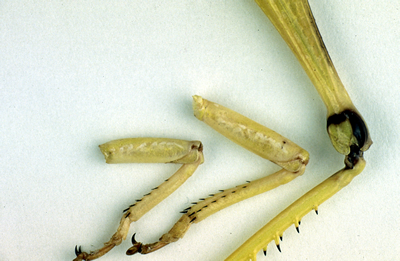
One of the main reasons a grasshoppers jumps is to escape from a predator. The best jump is therefore one which goes a long way, and does so as quickly as possible.
So just how well can a grasshopper jump?
The details obviously vary with the species and size (and sex) of the grasshopper, but a desert locust of the type shown on the title page can make a standing long jump of up to a metre, rising to a height of about 25 cms at the peak.
When any grasshopper jumps, it first has to completely fold (flex) its back legs. This is called the initial flexion. Then there is then a short delay, and then off it goes!
Both the initial flexion and the delay slow down the reaction time, so would seem to be a bad idea for an escape behaviour, but they are absolutely crucial to achieving a good jump. We'll see the reason for this later.
The peak acceleration during take-off approaches 20 g, which would probably squash a human.
Silly statistics - A locust is about 5 cms long, so if jumping ability scaled up in proportion to size, a human should be able to do a standing long jump of about 40 metres!
Here is a video of a real grasshopper jumping. Notice how the grasshopper tumbles in the air after take-off.
And here we have a close-up slow-motion (1000 fps) video of the moment of take-off:
A good jump needs two things:
Science stuff: equations of motion and some facts and figures.
To be precise (or reasonably so), a typical grasshopper weighing 2-3 g will thrust against the ground with a force which peaks at about 30 g when the legs are half extended, to give it a final take-off velocity of about 3 m s-1.
If you have ever tried to catch a grasshopper you will know how well they can jump, but if you actually manage to catch one you might discover that they are quite good at kicking, as well!
Kicking is a last-resort defense if jumping fails, and its effectiveness is increased by the sharp spines that line the back of the jumping legs. These cannot do any serious damage to a human, but they can certainly cause enough surprise to make the would-be catcher drop the grasshopper!

An effective kick has exactly the same requirements as an effective jump - a lot of force, delivered quickly. In fact, most of the specializations described in this website to explain jumping apply equally to kicking, and in many scientific studies kicking is used as a substitute for jumping. This is because grasshoppers will kick if they are restrained (so long as their back legs can move), and it is easier to study an animal that is restrained than one that is freely moving - for instance if you wanted to take a close-up photograph of its knee joint.
The ultimate source of the thrust comes from the contraction of the muscles inside the leg, so let's now see how the muscles make the leg move...